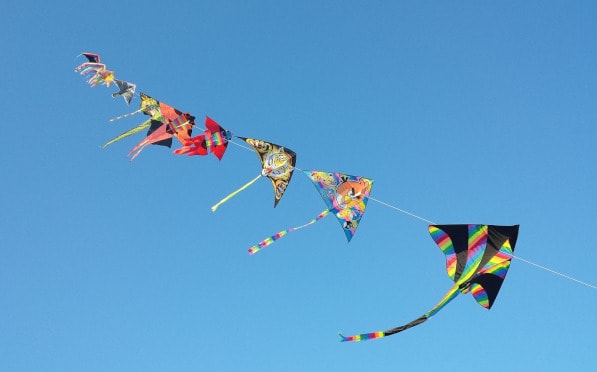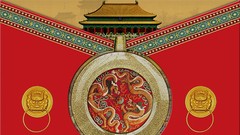
Kites can nowadays be seen in parks throughout the world, but they were invented in China more than 2000 years ago. Today, people usually use them for fun and entertainment, but they actually played an important role in Chinese history. We will describe the origin and history of Chinese kites, and you may be surprised with some facts you will find out.
Related reading: “Historical and Modern Facts about Chinese Kites” – Opens in a new tab.
The invention of kites
Kites were invented in China during the Warring States Period. In the beginning, they were used for military purposes and to gather information. The Warring State period is an era in Chinese history that lasted from 475 BC to 221 BC. It was a turbulent period, characterized by war and the division of states. In fact, some states demanded independence from the Zhou dynasty and they were fighting to get the territory. The Warring State period ended when another dynasty, the Qin dynasty, conquered other states, which meant the beginning of the Imperial period in China.
Who invented kites
It is believed that the first kite was invented by Chinese craftsman Mo Zi in the 5th Century BC. It is said that he worked for three years on building a kite and that he managed to build a man-lifting kite.
The other version claims that a prototype of a kite was made by Chinese philosopher and inventor Lu Ban. The first kite was in a form of a wooden bird that could stay in the air for two to three days. However, one thing is sure: kites originate from ancient China and they have a long history.
First kites were made in the shape of birds because it was believed that that shape was most suitable for flying. They were made of light wood or cloth. Throughout history, kites were made in different sizes and shapes, from birds to dragons and other animals that were considered important in China. Popular shapes also include butterflies and caterpillars.

The purpose of the first kites
In the beginning, the kites were used for military purposes and defense. They served to measure distance and detect wind direction. During the war period, if a large army had to move it was necessary to measure the distance somehow, so they can prepare. Kites were considered a revolution in the military world because they were able to provide soldiers with precious information that would otherwise be difficult to obtain.
They were also used for sending messages and sharing urgent information between the members of the same army who were distantly located. Sometimes they were used as a call for help.
Types of kites
It is possible to define three main types of Chinese kites, based on the materials used for making them throughout history. Every kite was made of three parts: frame, gluing, and decoration. The frame had to be light but strong enough, and it actually determined the shape of a kite. Chinese kites were usually made either of wood, paper, or silk.
Wooden kites
As it was mentioned before, the first kites were made of wood. They were called mu yuan and their use was highly practical. The first written mention of wooden kites can be found in the writings of the Chinese philosopher Mozi (470 BC – 391 BC). He described the way that wooden kites were made and used during the Warring States period.
Related reading: Innovation Through the Ages: Unraveling the Timeline of Chinese Inventions – Opens in new tab
Paper kites
Paper kites, so called zhu yuan, were developed much later. They appeared during the period of the Han dynasty (25 AD – 220 AD) because in that period paper became less expensive and commonly produced in China. Paper kites were used as an emergency sign, call for help. During the Second Sino-Japanese War, when Chinese capital Nanking was blocked, citizens of Nanking flown paper kites, asking for help. Today, paper kites can be seen in China and citizens appreciate them because they are considered part of Chinese tradition.
Silk kites
Silk kites appeared in the period of the Tang dynasty that ruled from 618 AD to 907 AD. Silk kites were more delicate and they were not used for military purposes. Instead, they were used for entertainment, pleasure, and home decorating. Artisans started competing who will design the most beautiful silk kite, and kite making became a unique form of artistic expression. They were decorating kites with details in various colors, adding flowers and calligraphy letters. Actually, Chinese kites can be compared to the most beautiful forms of Chinese art, such as Chinese umbrellas and Chinese traditional masks.

Click here to see some Chinese Kites designs – Opens in a new tab.
Chinese kites after 1000 AD
As we already mentioned, kites became very popular during the period of the Tang dynasty. Kite flying became a widespread activity, but mostly in the upper class. People usually used kites made of bamboo and silk. Noble families had richly decorated and hand-painted kites, that became a symbol of prestige. Those kites were very expensive so common people were not able to afford them.
The next invention was musical kites. Someone thought of putting bamboo pipes on the kite, so when the kite was flown the pipes were producing sounds similar to the sound of a traditional music instrument – zheng. In fact, the Chinese name for kite is fengzheng and it is actually composed of two words: feng – meaning wind in Chinese, and zheng – the name of traditional musical instrument.
Since the Qing dynasty that ruled from 1644 to 1911, kites are used mostly for entertainment, recreation and during celebrations. They became a favorite outdoor activity, popular in all social classes. Ordinary people may not have been able to afford silk kites, but they were making paper kites instead. It became a tradition to fly kites during the celebration of Chinese New Year and the Spring Festival, to bring good luck.
Kite design
Chinese kites often represented mythological creatures and characters from old Chinese legends and tales. They have also often been made in form of animals from the Chinese Zodiac, such as tiger, rooster or snake. Various details and decorations can be put on a kite to make it more beautiful. Kite decorating is a unique form of art. Red color symbolizes good luck and that is why kites are often painted in red or decorated with red details. Chinese culture is rich in symbols and there are various explanations for every color and every shape used. Some people attach small flutes and whistles to their kites, so they produce sound while flying.
Check out our “Free Culture Library“. We have compiled some great free resources, about Chinese culture, for your research.
Kite meaning
Kites have had various meanings through Chinese history. It was believed that they bring good luck and that is why they were flown on special occasions and during celebrations. Kite is also a symbol of hope and freedom. They were flown with hope that they will bring people health and happiness.
It was also believed that kites were able to send our greetings to deceased family members. On the Quingming Day they were flown in honor of our ancestors, to send them our love. It was believed that on that day gates of the otherworld open so our ancestors can receive our message. People also used to cut the kite line on purpose, so the kite would fly high and reach their ancestors. That can also symbolize letting go of all bad things and bad feelings that accumulated during the year.
In some parts of China, it was believed that kites can take away evil spirits and bad luck, and that is why they were sometimes made in a form of some dangerous animal.
Kite flying festivals
During the 20th Century, Kite flying festivals became very popular in China. They are organized in many cities, but the most popular one is the Weifang International Kite Festival, held every year in April. This festival is also the first international kite festival and it was organized for the first time in 1984. Weifang, Shandong is considered a kite capital of the world and the festival attracts many tourists from around the world. Every year, the most beautiful kite is rewarded as the Kite King.
Weifang is also home to the best Kite museum in the world. In the Weifang Kite museum it is possible to see an impressive collection of kites from all periods and learn more about their origin. Professionals are able to determine the period that one kite belongs to, just by examining the materials and decorations used.
Click here to see some Chinese Kites designs – Opens in a new tab.
Kites around the world
For a long period of time, kites were used only in China and nearby countries. Traders who visited China brought kites to India, Korea and other parts of Asia. It is believed that Marco Polo was the first to bring Chinese kite to Europe, after one of his famous trips to China in the 13th Century. He was also one of the first authors who wrote about the kites and explained to the Western audience how to use them. They spread from Europe to North and South America as well. However, kites did not become truly popular around the world until the 16th Century. During the 18th and 19th century they played an important part in various scientific experiments.
The role of Chinese kites has changed many times throughout history, but they are still curious and impressive as they were many centuries ago.
Related reading: “Historical and Modern Facts about Chinese Kites”
Online Courses about Chinese Culture from Udemy (Aff.link)

Stay in Touch
 Join our newsletter by using the forms on this website or click here!
Join our newsletter by using the forms on this website or click here! Follow us on Google News
Follow us on Google News Follow us on Facebook
Follow us on Facebook
Featured image: “0244” by JY_Studios is licensed under CC BY-NC-ND 2.0





